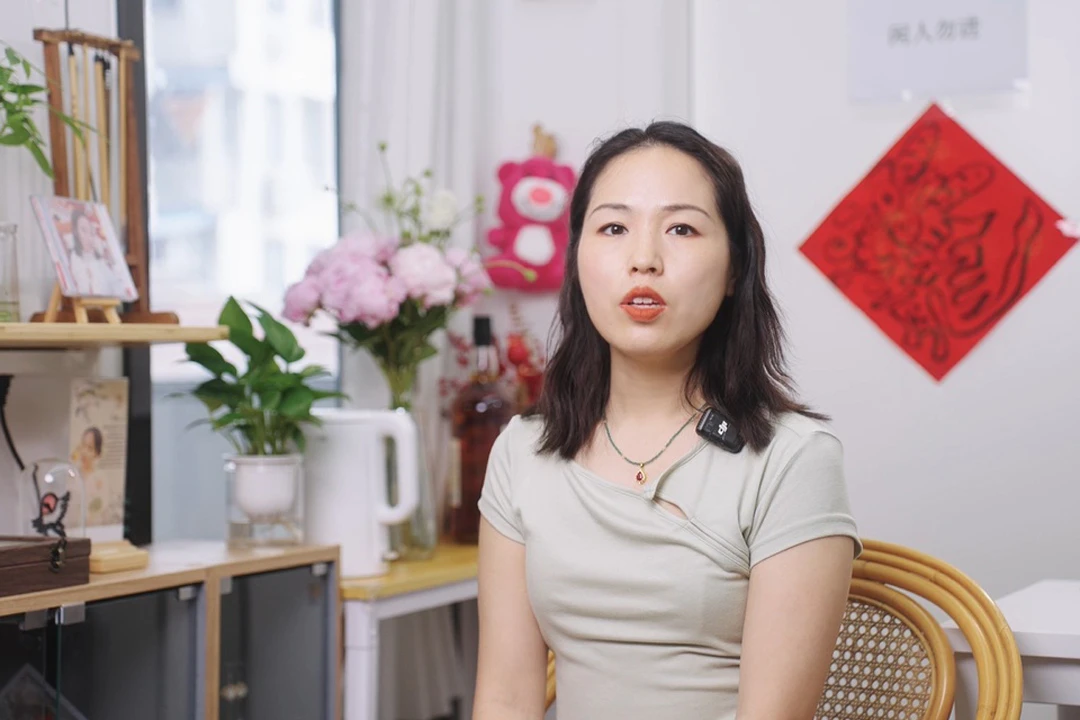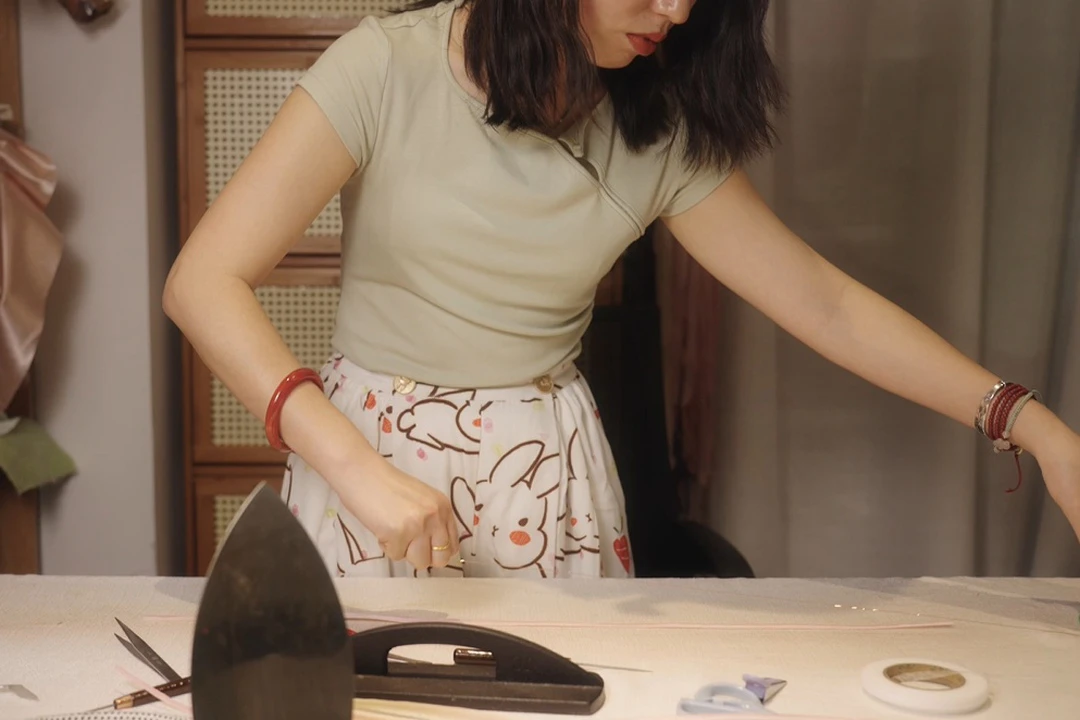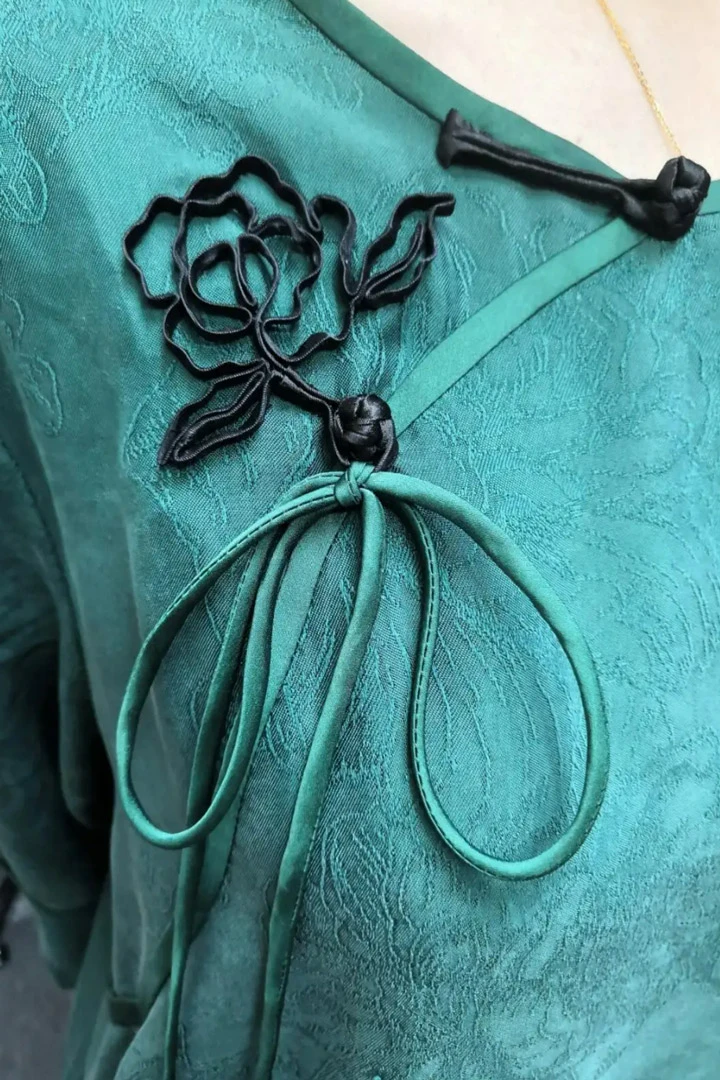In the heart of Shanghai’s Yuyuan Street, a company named Shanghai Huamanqin Cultural Creativity Co., Ltd. has become inextricably linked with the iconic Chinese traditional dress, the qipao. The founder, Li Qiang, has focused her attention on the intricate pankou (frog buttons) that adorn these elegant garments.
By combining the intangible cultural heritage of Shanghai-style pankou craftsmanship with innovative design, Li has created a range of pankou accessories, handicrafts, and educational courses, unlocking a world of entrepreneurial possibilities for young people through these tiny yet significant elements of the qipao.
Li’s fascination with pankou began with a simple question: “Could these buttons be removed from the qipao and transformed into standalone works of art?” Despite initial skepticism from family and friends, who believed she was focusing on something too small to be significant, Li remained steadfast in her belief in the unique charm of traditional pankou. She embarked on a journey to showcase the grandeur of traditional culture through these seemingly minor accessories.
As a student of fashion design, Li discovered that even the smallest elements of China’s 5,000-year history could be used to create innovative, unbeatable designs. Her deep love for the qipao was evident in her extensive collection of photographs featuring various styles of the dress.
However, during her journey to master the art of pattern-making and tailoring, Li struggled to grasp the essence of the craftsmanship behind the qipao and its pankou. Undeterred, she sought out teachers and studied diligently, all while contemplating the future development of traditional handicrafts and culture. Eventually, she found clarity and decided to focus on the pankou as her specialty.
The qipao allows Chinese women to showcase their graceful figures while exuding a subtle, elegant, and tranquil aura. Within a qipao, the pankou serves as the finishing touch, highlighting the garment’s beauty. Pankou originated from the ancient Chinese practice of tying knots to record events, dating back to the Han Dynasty. These small buttons, which combine various techniques such as coiling, sewing, wrapping, and twisting, along with color matching and splicing, embody the profound depth of Chinese culture in their intricate details.
Today, when discussing pankou, Li’s eyes sparkle with a deep love for traditional culture, and she can effortlessly recount the history and evolution of these buttons. As she speaks, her hands deftly execute each step of the process, from shaping petals and concave flowers to filling, starching, and ironing, bringing the intangible cultural heritage to life through cherry blossom and butterfly-shaped pankou.
Although pankou may appear delicate, their creation involves an intricate process. From material selection and design to cutting, lining, stitching, and shaping, each step demands meticulous attention to detail. Driven by her passion for traditional culture and unwavering dedication, Li spent over a year mastering this craft.
However, she was not content with simply replicating the traditional techniques; instead, she began incorporating modern elements into her pankou designs, creating innovative pieces. Li developed pankou accessories, handicrafts, and even pankou paintings, boldly combining the traditional craft with other intangible cultural heritage techniques such as embroidery, velvet flowers, and filigree.
She also experimented extensively with fabrics and materials, resulting in unique and captivating creations. For example, she wove the classic Western fairy tale “The Little Prince” into a pankou painting, creating a delightful surprise for viewers. Similarly, she used pankou craftsmanship to depict the well-known Chinese zodiac animals, bringing them to life with vivid, three-dimensional charm.
After establishing Shanghai Huamanqin Cultural Creativity Co., Ltd., Li Qiang seamlessly blended the allure of traditional clothing with modern design concepts, captivating an increasing number of consumers who fell in love with traditional Chinese fashion. A chance encounter led her to meet Liu Qiuyan, a representative inheritor of Shanghai-style qipao pankou craftsmanship.
Li formally became Liu’s apprentice, determined to combine intangible cultural heritage techniques with traditional Chinese fashion design through innovative reinterpretations. She opened her own studio in Huangpu District, creating the “Qiangqing” brand, and with the support of the Huangpu District Human Resources and Social Security Department, she took her first step towards developing “Qiangqing” at the Yuyuan Mall market. Her studio focuses on creative expression and offers an immersive experience of intangible cultural heritage.
Despite her busy schedule managing the studio, Li always finds time to respond to invitations, eagerly visiting schools, communities, and markets to share her knowledge of Shanghai-style qipao pankou craftsmanship with children, the elderly, and intangible cultural heritage enthusiasts, sowing the seeds of appreciation for this art form and traditional Chinese culture in the hearts of many.
The pankou on the sleeves of a qipao, like the knots in one’s heart, weave together the ancient charm of the East and the beautiful blueprint of a ’90s entrepreneur’s journey. Although small in size, pankou encapsulates the unique cultural connotations of the Chinese nation. “In the future, I hope to pass on the craft of pankou, encouraging more people to appreciate the traditional culture of the qipao and experience its allure,” Li shares.
Li Qiang’s story is a testament to the power of passion, perseverance, and innovation in preserving and promoting traditional Chinese culture. By focusing on the intricate art of pankou, she has not only created a successful business venture but also become a guardian of intangible cultural heritage. Her dedication to sharing her knowledge and skills with others ensures that the legacy of pankou and the qipao will continue to thrive for generations to come.
As more young entrepreneurs like Li Qiang step forward to embrace and celebrate traditional Chinese craftsmanship, they play a vital role in bridging the gap between the past and the present. By infusing modern design elements and innovative thinking into age-old techniques, they breathe new life into these art forms, making them relevant and appealing to contemporary audiences. This fusion of tradition and innovation not only preserves the essence of Chinese culture but also sparks a renewed interest in and appreciation for the country’s rich heritage.
Furthermore, Li’s commitment to education and community outreach highlights the importance of cultivating a deep understanding and love for traditional arts among people of all ages. By engaging with children, the elderly, and intangible cultural heritage enthusiasts, she is planting the seeds of cultural appreciation that will grow and flourish for years to come. This grassroots approach to cultural preservation ensures that the knowledge and skills associated with pankou and the qipao are not only maintained but also actively practiced and cherished by future generations.
As we celebrate the efforts of “art guardians” like Li Qiang, we are reminded of the invaluable role that traditional craftsmanship plays in shaping our cultural identity and connecting us to our roots. Through their dedication, creativity, and passion, these young entrepreneurs are ensuring that the rich tapestry of Chinese culture remains vibrant, relevant, and accessible to all. By supporting and encouraging their endeavors, we can all play a part in safeguarding the future of our intangible cultural heritage, one stitch, one knot, and one pankou at a time.



